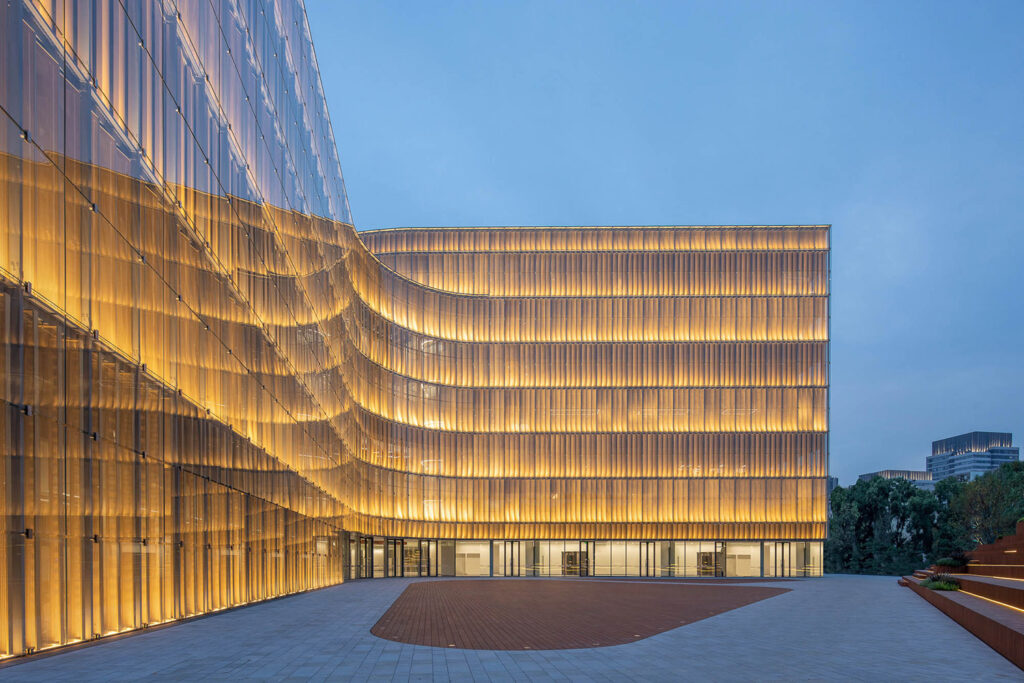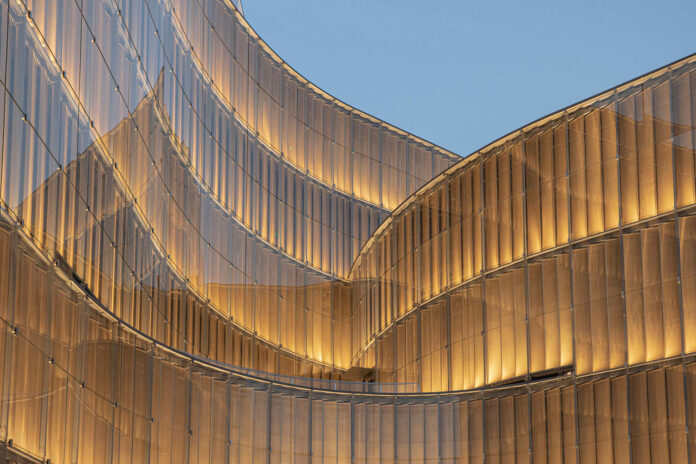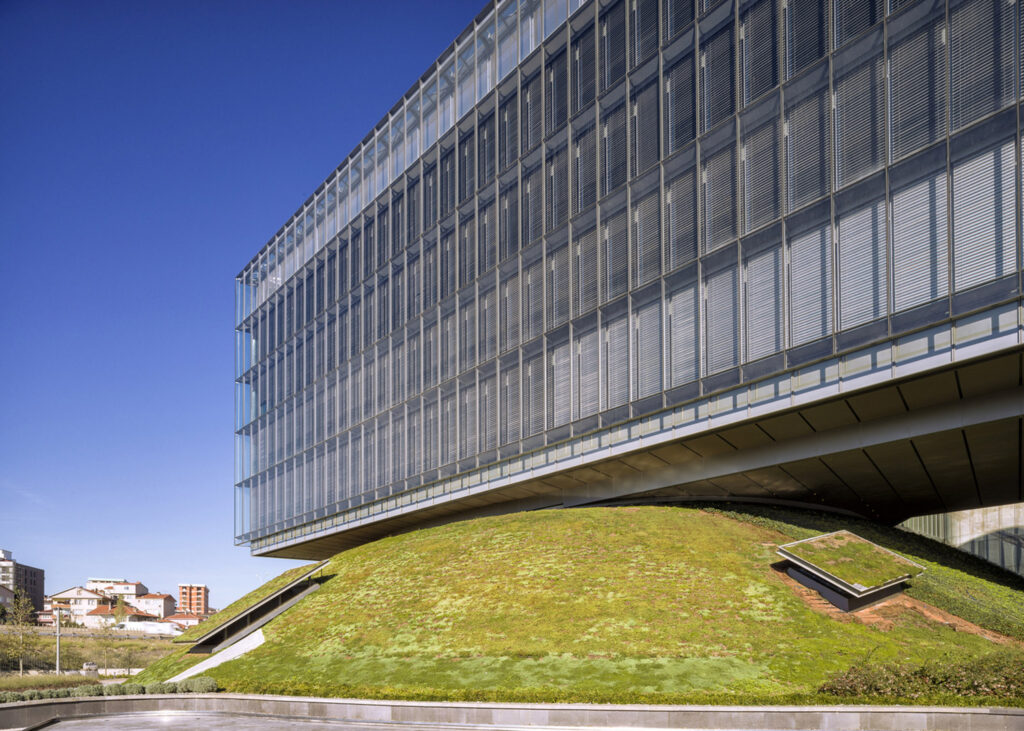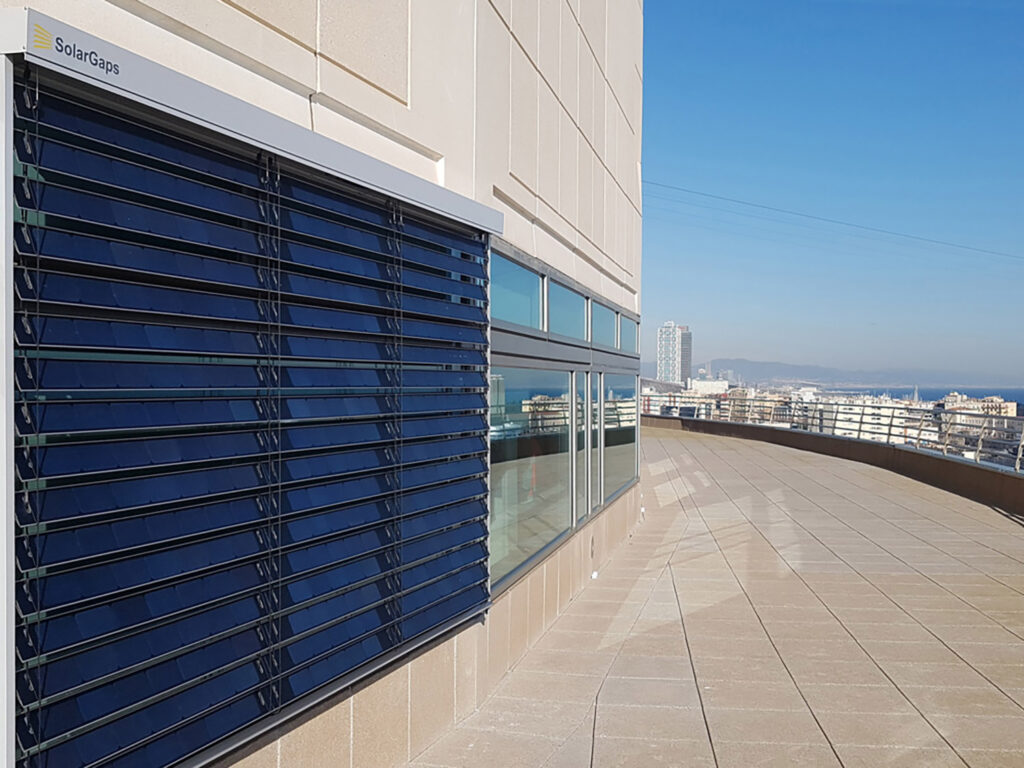Dynamic solar shading technologies represent a pivotal advancement in facade engineering, combining scientific principles with cutting-edge innovations to address glare reduction and energy efficiency. Through sun-tracking capabilities, IoT integration, AI-driven optimization, and material advancements like smart materials and PV glass, these systems redefine the relationship between architecture and environmental performance.
From Passive to Active:
The Evolution of Solar Shading Systems
Solar heat gain and glare are critical challenges in modern architecture, particularly in buildings with extensive glass facades. Solar heat gain refers to the increase in temperature inside a building due to sunlight entering through windows, while glare disrupts visual comfort and productivity. Dynamic shading systems address these issues by regulating the amount of sunlight entering a building, reducing heat buildup and improving interior lighting conditions
Studies indicate that buildings equipped with dynamic shading can achieve up to 30% reductions in lighting-related energy consumption and cooling costs. This dual benefit not only reduces operational expenses but also aligns with sustainability goals by lowering carbon emissions.
Technological Innovations in Dynamic Shading Systems
Sun-Tracking Capabilities for Optimal Solar Control
Modern dynamic shading systems incorporate sun-tracking capabilities that adjust facade elements based on real-time solar trajectories. Using sensors and actuators, these systems ensure optimal shading throughout the day, maximizing energy efficiency while preventing excessive heat gain or glare.
IoT Integration for Real-Time Adjustments
IoT-enabled shading systems enhance responsiveness by allowing real-time adjustments based on environmental data such as sunlight intensity, temperature, and wind conditions. These interconnected systems communicate with building management platforms to optimize shading performance dynamically, ensuring seamless integration into smart environments.
AI-Driven Predictive Shading Systems
Artificial intelligence further advances dynamic shading technologies by enabling predictive adjustments based on historical weather data and satellite imagery. AI algorithms anticipate changes in sunlight patterns and optimize shading configurations before environmental conditions shift, ensuring consistent performance and energy savings.
For example early 2025, MHT Technologies and Somfy have partnered to enhance commercial buildings with AI-driven shade automation, optimizing lighting, temperature, and energy efficiency in real time. This collaboration combines smart building solutions with advanced motorized shading for improved comfort and sustainability in commercial buildings 1.
Material Advancements in Solar Shading
Smart Materials for Adaptive Facades
Smart materials are transforming dynamic shading systems by enabling passive responses to environmental changes. For example, thermochromic materials adjust their transparency based on temperature, reducing solar heat gain without requiring external energy inputs. These materials enhance energy efficiency while maintaining aesthetic appeal.
Semi-Transparent Photovoltaic Glass for Dual Functionality
Semi-transparent photovoltaic (PV) glass integrates solar energy generation into shading systems while allowing natural light transmission. This dual functionality enables buildings to produce clean electricity while optimizing interior lighting conditions. PV glass is particularly beneficial for facades and skylights, where both energy generation and daylighting are critical design considerations.
Smart Blinds with built-in solar panels
Solar Gaps specializes in solar shading systems that integrate photovoltaic (PV) technology into window blinds. Their smart blinds automatically adjust based on sunlight exposure, optimizing energy efficiency while generating electricity. By using built-in solar panels, these blinds can reduce indoor cooling needs while supplying power to the building. This dual-functionality aligns with advancements in semi-transparent PV glass, allowing for both shading and solar energy production. Solar Gaps’ solutions are particularly useful for urban environments where maximizing renewable energy within limited space is crucial.
Shading Strategies
A Guide for Engineers and Architects
Successfully integrating dynamic shading requires a holistic design approach, considering the building’s orientation, local climate, and occupancy patterns. Early-stage simulations using software like Radiance or EnergyPlus are crucial for optimizing shading strategies. These simulations enable engineers to quantify annual sunlight exposure (ASE) and daylight autonomy (DA), aiming for an ASE < 10% and DA > 50% for visual comfort.
Key technical aspects include:
- Sensor Placement: Strategically locating light and temperature sensors on the facade, typically at a density of one sensor per 50-100 m², ensures accurate real-time data.
- Control System Integration: Linking shading devices to the BMS allows for coordinated operation, optimizing both energy efficiency and occupant well-being.
- Material Selection: Choosing materials with high solar reflectance (SR) values (SR > 0.7) for shading elements minimizes heat absorption, reducing cooling loads.
- Color Selection: The visible light transmittance (VLT) values, ranging from 0.1 to 0.8, enables designers to control the amount of light entering the building. Coatings with specific spectral properties can filter out UV radiation, protecting interior materials.
- Shape Design: Custom shapes, often fabricated using advanced manufacturing techniques like CNC milling or 3D printing, can enhance shading performance. Angled louvers, for instance, can effectively block direct sunlight while preserving views.
- Transparency Levels: Semi-transparent photovoltaic (STPV) panels, with transparency ranging from 10% to 50%, offer a balance between energy generation and daylighting. These can achieve energy payback times (EPBT) of less than 5 years, making them a sustainable choice.
These considerations enable architects and engineers to design dynamic shading systems that are both aesthetically pleasing and high-performing, enhancing building sustainability and occupant experience.
Fighting Energy Bills with Solar Power
The High-Tech Hunt
Addressing Cost, Maintenance, and Durability Concerns
Dynamic solar shading systems face significant cost barriers, with advanced motorized units costing 20-30% more than static alternatives. High-performance materials like electrochromic glass or shape-memory alloys further escalate expenses. However, lifecycle cost analyses reveal long-term savings: automated shading can reduce HVAC energy use by 15-40% and lighting loads by 20-30%, offsetting initial investments. Maintenance challenges arise from moving parts, such as servo motors, which require regular lubrication and calibration. To mitigate this, manufacturers now use self-lubricating polymers and corrosion-resistant alloys (e.g., marine-grade aluminum) to extend service life. Durability is enhanced through ISO 9001-certified testing for 50,000+ operational cycles, ensuring reliability in extreme climates. Modular designs also simplify component replacements, reducing downtime.
Overcoming Partial Shading Issues with Advanced Technologies
Partial shading, caused by adjacent buildings or vegetation, can reduce solar harvesting efficiency by 10-25% in BIPV-integrated systems. Innovations like half-cut solar cells minimize losses by isolating shaded sections, while bifacial panels capture reflected light to boost yields. Dynamic systems now employ ML-driven predictive algorithms (e.g., solar path simulations) to preemptively adjust shading angles, ensuring optimal performance even under variable conditions. Embedded IoT sensors monitor micro-shading patterns, enabling real-time adjustments to louver spacing or panel tilt. For example, a Zurich office retrofit achieved 82% to 92% shading efficiency using these technologies despite urban obstructions.
Future Trends in Dynamic Solar Shading
Automation and Machine Learning in Facade Design
Next-gen systems leverage AI-powered digital twins to simulate shading performance across seasons. Machine learning algorithms, trained on historical weather data, predict solar paths with <5% deviation, enabling proactive adjustments. For instance, Siemens’ Desigo CC platform uses neural networks to optimize shading in real-time, slashing cooling costs by 35% in pilot projects.
Enhancing Sustainability with Circular Economy Principles
Modular shading components are now designed for cradle-to-cradle reuse. Aluminum louvers with 95% recycled content and PV-integrated glass panels with recoverable indium tin oxide layers reduce embodied carbon. Manufacturers like Kingspan offer leasing models for shading systems, reclaiming materials for refurbishment at end-of-life.
The Transformative Potential on Urban Energy
Efficiency City-scale adoption could cut urban cooling demands by 25%, per IEA projections. Projects like Singapore’s Punggol Digital District demonstrate networked shading systems that balance energy generation and microclimate management, reducing district-level peak loads by 18%.
Conclusion
Dynamic solar shading systems are transforming building performance, offering solutions that balance energy efficiency, occupant comfort, and aesthetic integration. Architects and façade engineers play a crucial role in designing and implementing these advanced systems by integrating responsive materials, IoT-driven automation, and predictive AI technologies. Their expertise ensures that shading strategies align with sustainability goals, urban energy efficiency, and user experience. As material innovations and digital tools evolve, the collaboration between designers, engineers, and technology providers will be key to developing shading solutions that enhance both building performance and environmental impact. The future of facades lies in adaptive, high-performance systems that respond intelligently to the changing climate and urban constraints.
I think I’d go mad if I didn’t have a place to escape to. You have to stay true to your heritage, that’s what your brand is about.
Useful Links
https://pmc.ncbi.nlm.nih.gov/articles/PMC9944834
https://www.mdpi.com/2075-5309/15/7/1123
Case studies
Garanti Bank BBVA Technology Campus, Istanbul, (2019)
ERA Architects
Garanti Bank BBVA Technology Campus in Istanbul, designed by ERA Architects, integrates a sophisticated dynamic solar shading system to optimize energy performance and occupant comfort. The facade features motorized louvers that adapt to the sun’s position throughout the day. These louvers are controlled by sensors and AI algorithms, enabling real-time adjustments that minimize glare and reduce solar heat gain.
This dynamic shading system is designed to reduce cooling loads by up to 40% and optimize natural lighting, cutting down on artificial lighting consumption by 30%. The building utilizes IoT-enabled sensors that respond to environmental conditions. By integrating these technologies, the campus achieves significant energy savings. In effect, the responsive facade minimizes its reliance on mechanical systems. It promotes a productive and sustainable environment within.

YOFC Headquarters, Wuhan, China (2023)
Architects: Gensler
YOFC Headquarters in Wuhan, China (2023), designed by Gensler with facade consulting by Inhabit Shanghai, showcases advanced dynamic solar shading technologies. The facade incorporates AI-driven sun-tracking capabilities, with sensors adjusting panel positioning in real-time based on satellite imagery and predictive solar patterns. These adaptive shading strategies act as the building’s “sunglasses,” optimizing natural light while reducing glare and solar heat gain. This IoT-enabled system creates comfortable microclimates and significantly cuts cooling costs, potentially reducing HVAC demands by up to 30%. While exact energy-saving figures remain proprietary, the design contributes to a lower carbon footprint and improves overall building energy performance.

As the Editor of FacadeToday.com, I merge my passion for Design, Architecture and Technologies with three decade of experience collaborating with entrepreneurs across many industries. My career has centered on fostering innovation, scaling business opportunities, and bridging gaps between technical experts, business developers, and creative visionaries. I thrive at the intersection of sustainable solutions, material advancements, and smart technologies, curating insights on themes like energy-efficient facades, smart tech, and advanced manufacturing. With a commitment to lifelong learning, I aim to empower architects and facade engineers by translating innovations into actionable knowledge, driving the industry forward through purposeful connectivity and cutting-edge practices.






